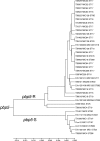Analysis of PBP5 of early U.S. isolates of Enterococcus faecium: sequence variation alone does not explain increasing ampicillin resistance over time
- PMID: 21576454
- PMCID: PMC3122385
- DOI: 10.1128/AAC.00099-11
Analysis of PBP5 of early U.S. isolates of Enterococcus faecium: sequence variation alone does not explain increasing ampicillin resistance over time
Abstract
Recent studies have shown that ampicillin resistance has increased steadily over the past 3 decades within U.S. Enterococcus faecium isolates. Analysis of the predicted PBP5 protein of 41 isolates showed a consensus PBP5 pattern for the 9 isolates with MICs of <4 μg/ml that is distinctly different from the PBP5 consensus of the 32 isolates with MICs of >4 μg/ml with ∼5% difference between these; however, there were no consistent amino acid changes that correlated with specific increases in the MICs of ampicillin within the latter group. Analysis of three other genes encoding cell wall/surface proteins also showed that there are two distinct evolutionary groups for each gene, but with occasional mixing of genes, consistent with a species that evolves by recombination.
Figures


References
-
- Clinical and Laboratory Standards Institute 2006. Performance standards for antimicrobial susceptibility testing; 16th informational supplement M100-S16. Clinical and Laboratory Standards Institute, Wayne, PA
Publication types
MeSH terms
Substances
Grants and funding
LinkOut - more resources
Full Text Sources
Miscellaneous

